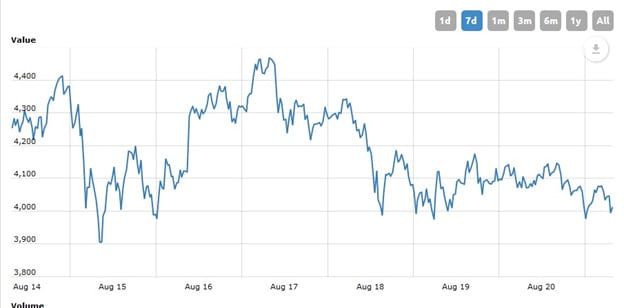
Bitcoin reached a price of $4,466 on August 16, 2017, before retreating sharply to $3,989 on August 18, 2017. It has since consolidated in a tight trading range between $4,160 on the high-end and $3,979 on the low end. The explosive rally of the past 1-month gained momentum on 2 August 2017 and reached a high two weeks later. It has largely been holding above the critical $4,000 support level, and trading volumes remain high.
At the beginning of August, Bitcoin broke through the $3,000 level after it split into two parts – Bitcoincash (BCC) and Bitcoin (BTC). Currently Bitcoin cash is trading at $561.95 per unit, down 22.05% (on Monday, August 21, 2017). BCC has a significantly lower price than BTC (by a factor of 5). The fork in Bitcoin allowed the BTC variant to rally significantly, while BCC failed to gain traction.
Bitcoin has failed to maintain the bullish momentum of the past three weeks, and seems to have plateaued out around the $4,000 level. At the start of the week, the BTC/USD rate was $4003.26, down 1.55%. This trend has been evident for several days, as BTC retreated from $4,466 earlier in the month. Nonetheless, analysts remain confident that Bitcoin will continue its bullish trends. Thanks to positive sentiment among many Wall Street analysts, BTC is holding up strongly.
A cursory glance at the recent performance of this cryptocurrency confirms that it has outpaced all other asset classes in the market. Traditional brokers and online brokers alike have reported a sharp uptick in demand for cryptocurrency like Bitcoin, Bitcoincash, Litecoin, and Ethereum. The current market capitalization of Bitcoin/USD is $66.01 billion, with 16.51 million coins in circulation.
A leading analyst from one of the world’s premier online brokerages, Trade-24 Johnson Monger believes that Bitcoin is going to be the asset of the future,
‘We are looking hard at Bitcoin derivatives markets as the next big thing. Many traders and investors already believe that this is imminent. Institutional brokerages are going to be increasing their holdings in BTC over the next 6 months and we will invariably see high transactions volumes taking place.
I believe that by 2018 we could see this digital currency surpassing the $6,000 level, and based on its current trading level ($4,000) that is a 50% increase. If we extrapolate over the next 4 years it is not out of the realms of possibility that Bitcoin could reach $20,000 – $25,000. The rationale for these lofty expectations for BTC are related to the huge volume of activity (transactions by users and Bitcoin addresses). We see a sharp uptick in this type of activity and it is likely to continue.’
ICOs are the digital currency equivalent of IPOs. An ICO is an initial coin offering, and it is quickly taking over where initial public offerings (IPOs) were dominant. An ICO is a digital currency’s way of seeking capital in the financial markets. Venture capitalists and investors plough money into cryptocurrency companies in this way. To date, there are an estimated 700+ cryptocurrency markets in operation, with a market valuation of well over $120 billion.
By far the biggest cryptocurrency market is Bitcoin, and it has dominated since inception. Newbie traders and investors routinely ask the question ‘What is an ICO’; fortunately the answer to this is found in blockchain technology and tokens. Blockchain technology refers to the peer to peer, decentralised algorithm that governs transactions. Tokens are the coins that are offered during the ICO – much the same as shares that are bought in an IPO.
ICO’s are conducted to raise capital for startup ventures, and to continue financing cryptocurrency. The very first ICO launched in 2013, known as Mastercoin. At the time it raised $600,000. As always with investments that burn red-hot, caution is the order of the day. For now, Bitcoin is surging and digital currencies all the rage, but market forces and regulatory constraints may reverse this trend.